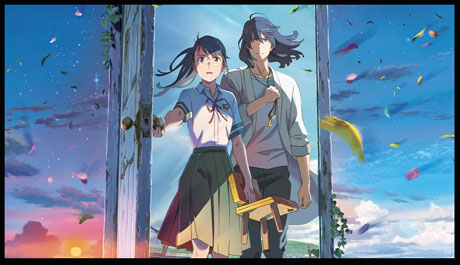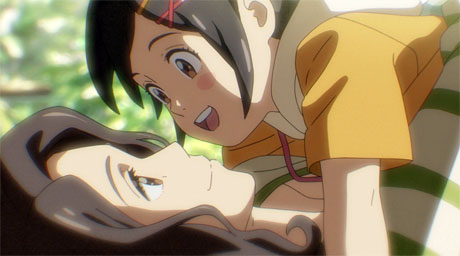
Over the last 15 years, Makoto Shinkai has emerged as one of the leaders of a new generation of anime directors who are pushing storytelling in interesting new directions.
In Suzume (Suzume no Tojimari—literally, “Suzume’s Closing or Locking,” 2022), the title character begins as a normal high school girl, living with her aunt. Her mother was killed in the earthquake and tsunami that struck the Fukushima region of Japan in 2011. On her way to school, a handsome young man asks her if there are any ruins in the vicinity. Suzume follows him to an abandoned amusement park where she helps him shut a door that seems to be a supernatural portal. Shouta explains that he has been charged with closing doors that would enable worm-like monsters to cause earthquakes. Suzume has to continue his mission after Shouta is transformed into a three-legged chair by the mischievous cat spirit Daijin.
The film should be strong candidate for for Annie Award nominations and the Oscar for Animated Feature. Shinkai talked about Suzume on a recent visit to LA, speaking through translator Mikey McNamara.

Charles Solomon: In the Japanese press, you said the idea for the film came from seeing so many rural villages that are being or have been abandoned as the population declines and young people move to the cities. You commented that when work begins on a new building a Shinto groundbreaking ceremony, a jichin-sai, is held but there’s no corresponding ceremony when a building is closed.

Makoto Shinkai
CS: When you were designing the film, did you visit specific places for inspiration and reference material?
MS: When I completed the basic plot and summary of the film, a few staff members and I took a trip from Kyushu all the way to the Tohoku area. We stopped by quite a few areas that had been abandoned for various reasons.
It’s a little more difficult to experience the loss in Tokyo. But even there, we see the akiyas, houses that have been abandoned for various reasons. The same is true in Nagano Prefecture, my hometown. Because of the shrinking population, the footprint humans have left developing habitable areas is shrinking and has become less and less visible. The gap is being filled by a resurgent wilderness: There’s a story on the news about someone who’s been attacked by a bear or some other wild creature almost daily.

CS: Suzume survived the Great East Japan Earthquake (2011)—which Americans refer to as Fukushima. But unlike the heroines in many American animated films, she doesn’t have or acquire superpowers. Any brave, resourceful high school girl could do what she does.
MS: For Suzume, I imagined a young female protagonist. Kiki’s Delivery Service, which is really a coming-of-age story, an adolescent girl growing through her journey was a huge influence. Kiki’s only so-called superpower is that she can fly, so she opts for the delivery industry. In Suzume’s case, I would say she doesn’t have any kind of superpower that automatically helps her solve the problems she faces. Her power is much more subtle and small: Having experienced trauma and a near-death experience as a child, she’s able to see the worms that cause earthquakes. She can see or sense disaster. That’s her only power, and it doesn’t necessarily help her solve anything. I didn’t want the character to feel too different from the movie-going audience.
CS: But she bears the scars of her traumatic experience, and when she finds an ally in the dashing Shouta, she loses much of his support when Daijin turns him into a broken chair.
MS: I gave the chair only three legs as a metaphor for Suzume’s state of mind and the wounds she carries from the trauma she suffered as a little girl. The chair, like Suzume, is able to stand on only three legs; it’s able to walk and run. Although it’s not perfect, it’s able to fulfill all the functions you need from a chair. It’s a metaphor; even if there’s one important thing missing, you can still live, and you can still run. I wanted to tell people that you don’t necessarily have to be perfect in the movie.
Because it’s a real life disaster we’re dealing with, a more direct interpretation would have made the film very dark and heavy, which is not what I wanted. From the very onset, I wanted to make sure we had elements that would offset the darkness with humor to create a better balance.

CS: In Suzume, you return to the theme you explored in Your Name (2016): the trauma the Japanese people still suffer from the Great East Japan Earthquake. You cite Haruki Murakami’s short story “Super-Frog Saves Tokyo” as an influence on Suzume. In “Underground,” Murakami talks about the Hanshin Awaji earthquake and the Aum Shinrikyo sarin gas attack, both of which occurred in 1995, as turning points in Japanese life: There is a time before them and a time after them. Did the Great East Japan Disaster mark a similar break?
MS: It was certainly a turning point for Japan—and for myself as a director, in a similar way to how the Hanshin Awaji earthquake affected Murakami. As a creator, you never know when you’re going to experience certain things throughout your life. When the the Great East Japan Earthquake struck in 2011, I was about 37. I was still on the younger side as a creator, and I think I hadn’t really found the core that would serve all my projects moving forward. In some ways, the earthquake, guided me or changed me; it made me feel that as a creator, as an animation director, this is perhaps the meaning behind my films. For younger creators in their 20s and 30s, I think the COVID-19 may become a turning point for them– their equivalent of my earthquake.
CS: One last question: Although you’re doing publicity for Suzume, have you started a new film?
MS: I guess you could say we’re in pre-production. A lot of the pre-production phase consists of things I do alone with occasional feedback from the producers. But until I’ve completed the storyboards, it’s a very lonely process: Right now, I’m fighting this lonely battle by myself.
- Charles Solomon’s Animation Year End Review 2023 - December 28, 2023
- INTERVIEW: Makoto Shinkai on “Suzume” - November 27, 2023
- Interesting Portrayals of Gay Men in Manga/Anime - June 12, 2023


 November 27th, 2023
November 27th, 2023  Charles Solomon
Charles Solomon  Posted in
Posted in  Tags:
Tags: 






